

Les Phéniciens. Archéologie. Civilisations Précolombiennes. Carmen Bernand, Les Olmèques, le jade et le jaguar - Clio - Voya. Il y a des civilisations qui semblent surgir du néant, sans que l'on puisse déceler les préalables tâtonnements qui menèrent par paliers à la perfection des formes matérielles, reflet de la complexité sociale.
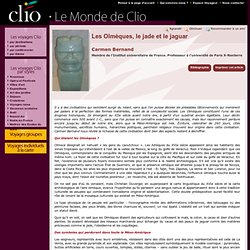
Les Olmèques constituent l'une de ces énigmes historiques. Ils émergent au XIIe siècle avant notre ère, à partir d'un substrat ancien égalitaire. Leur déclin commence vers 500 avant J. -C., sans que l'on puisse en connaître exactement les causes, mais leur rayonnement perdure encore jusqu'au début de notre ère, alors que la Méso-Amérique est née. Écriture, calendrier de 260 jours, cités monumentales, sacrifices humains, hiérarchies politiques, panthéon religieux trouvent leur origine dans cette civilisation. Qui étaient les Olmèques ? Olmeca désignait en nahuatl « les gens du caoutchouc ». Quoi qu'il en soit, on sait que les Olmèques étaient des agriculteurs qui cultivaient le maïs, le coton, le cacao et bien d'autres plantes.
Des symboles qui perdurent dans toute la Méso-Amérique. National Geographic News @ nationalgeographic.com. Last week Zahi Hawass, Director of Egypt's Giza Pyramids, announced the discovery of 11 new mummies at the Bahariya, an oasis city located 300 miles (480 kilometers) southwest of Cairo.
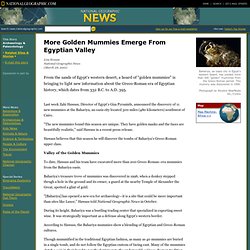
"The new mummies found this season are unique. They have golden masks and the faces are beautifully realistic," said Hawass in a recent press release. Hawass believes that this season he will discover the tombs of Bahariya's Greco-Roman upper class. Valley of the Golden Mummies To date, Hawass and his team have excavated more than 200 Greco-Roman–era mummies from the Bahariya oasis. Bahariya's treasure trove of mummies was discovered in 1996, when a donkey stepped thrugh a hole in the ground and its owner, a guard at the nearby Temple of Alexander the Great, spotted a glint of gold. "[Bahariya] has opened a new era for archaeology—it is a site that could be more important than sites like Luxor," Hawass told National Geographic News in October. Surprise Find Hawass says he plans to open the sarcophagus soon. The Basenji in Ancient Egyptian Art.
The Anubis Debate. Drhawass.com - Zahi Hawass. GRAN - Archeonavale.org. Revue d’Assyriologie et d’archéologie orientale - Puf. Archeology Research - Chaco Canyon, New Mexico. The Chaco Canyon Research Center had done aerial photography and a ground survey.
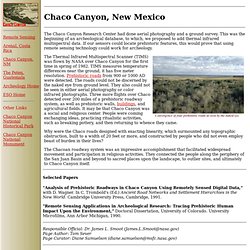
This was the beginning of an archeological database, to which, we proposed to add thermal infrared multispectral data. If our sensors could locate prehistoric features, this would prove that using remote sensing technology could work for archeology. The Thermal Infrared Multispectral Scanner (TIMS) was flown by NASA over Chaco Canyon for the first time in spring of 1982. TIMS measures temperature differences near the ground, it has five meter resolution. Prehistoric roads from 900 or 1000 AD were detected. Why were the Chaco roads designed with exacting linearity, which surmounted any topographic obstruction, built to a width of 20 feet or more, and constructed by people who did not even employ beast of burden in their lives? The Chacoan roadway system was an impressive accomplishment that facilitated widespread movement and participation in religious activities.
Archéologie au Ministère de la culture et de la communication - Retourner à la page accueil Recherche avancée.
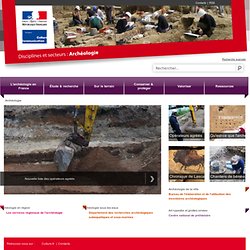
Mysteries of Egypt @ nationalgeographic.com. The nomes of Egypt - Upper Egypt. Egypt - Land of Eternity. La religion égyptienne, dieux et déesses (A) Anubis, God of Embalming and Guide and Friend of the Dead... ByCaroline SeawrightOctober 8, 2001 Updated: December 19, 2012 6 Comments Anubis (Inpew, Yinepu, Anpu) was an ancient Egyptian god of the underworld who guided and protected the spirits of the dead.
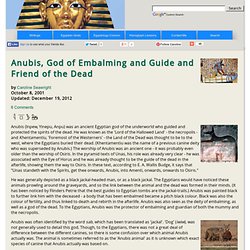
He was known as the 'Lord of the Hallowed Land' - the necropolis - and Khentamentiu, 'Foremost of the Westerners' - the Land of the Dead was thought to be to the west, where the Egyptians buried their dead. (Khentamentiu was the name of a previous canine deity who was superseded by Anubis.) The worship of Anubis was an ancient one - it was probably even older than the worship of Osiris. He was generally depicted as a black jackal-headed man, or as a black jackal. Anubis was often identified by the word sab, which has been translated as 'jackal'. Their results indicate that "C. a. lupaster shows closer resemblance to wolves than to jackals": The Egyptian jackal (Canis aureus lupaster) has hitherto been considered a large, rare subspecies of the golden jackal (C. aureus). Bahnasa-1 « Egyptian Monuments. Archaeology Magazine. MMSH - Maison méditerranéenne des sciences de l'homme - default.
IFAO - Institut français d'archéologie orientale. Cultural and Paleontological Resources, and Tribal Consultation. The vast public lands entrusted to the Bureau of Land Management hold some of the most significant evidence of human prehistory and history in the West and Alaska, the once-untamed frontier lands that lend America so much of its self-image.

These Western and Alaskan lands also count among the world's very best outdoor laboratories for studying the fossilized remains of plant and animal life, which span from the tens of thousands to the hundreds of millions of years in age. Humans have used and occupied the public lands for more than 10,000 years. In all that time the land has changed. And more than we might realize, human use has played a significant part in changing the land. Long-abandoned archaeological sites and historic landscapes give us important insights into the ways human activities and the environment have linked together through time, how seemingly minor cultural practices can contribute to substantial environmental change.
GRAT - accueil. Musées: Salle d'Exposition des Fouilles Archéologiques de Javols. -3. Association Toulousaine d'Egyptologie Selkis. Archéologie : la Gaule vue du ciel - une vidéo Hi-Tech et Scienc.